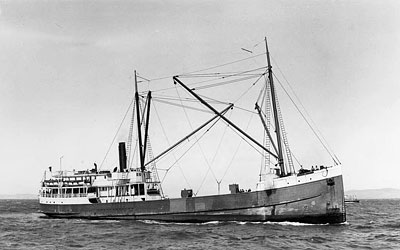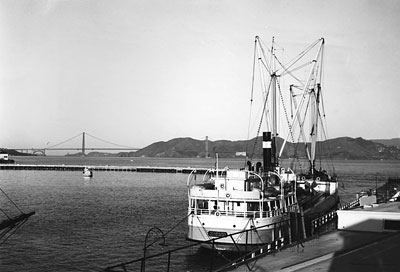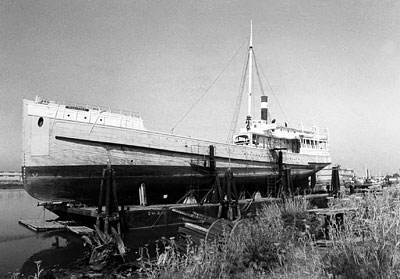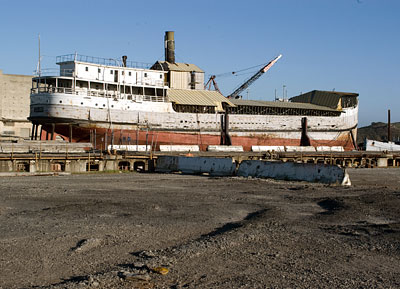National Register of Historic Places in San Francisco
Wapama Steam Schooner
Built 1915
Wapama was the last surviving example afloat of some 225 steam schooners specially designed for use in the 19th and 20th century Pacific Coast lumber trade and coastwise service. These vessels formed the backbone of maritime trade and commerce on the coast, ferrying lumber, general cargo and passengers to and from urban centers and smaller coastal settlements.
Adapted from the National Register of Historic Places Inventory Nomination Form dated 17 December 1982.

....And the 217-foot-long steam schooner Wapama has been neglected for so many years, that she is dry-docked in Sausalito, unfit for display at the Hyde Street Pier.
"Those ships are a priceless national resource that need to be protected," says William Whelan, former superintendent of the Golden Gate National Recreation Area and now a consultant on federal projects. "I think personal differences need to be set aside (so) they can be saved...."
From Sinking into Oblivion: Neglect Is Turning a Once Proud Fleet into a Heap of Flotsam by Gerald D. Adams, Examiner Urban Planning Writer (San Francisco Chronicle, 8 December 1996)

....The 215-foot-long wooden steamship, which is owned by the National Park Service, has been a landmark in Sausalito since 1986. But the old workhorse is rotting away, and attempts to restore it to its former glory have repeatedly failed.
The U.S. Army Corps of Engineers, which owns the dock where the Wapama sits on a barge, needs the space as part of a planned expansion of the adjacent Bay Model interpretive center. The Wapama, they say, will have to go.
The corps and the National Park Service entered into a two-year agreement to dock the Wapama in Sausalito 14 years ago, so it never was the intention that this would be a permanent home,'' said Donna Shepard, spokeswoman for the Corps of Engineers. ``We think it is important that the Wapama be moved to a facility that is equipped to do the level of restoration work that is needed.''
A plan to move the ship to Pier 54 in San Francisco recently fell through, and now the National Park Service is negotiating with Richmond's port authority for a berth at its old naval shipyard....
The Wapama is the last of 225 wooden steam schooners -- successors to the sailing vessels called lumber schooners -- built between the 1880s and the 1920s. The ships, built exclusively on the West Coast, steamed up and down the coast hauling lumber, passengers and, occasionally, less wholesome commodities.
Built almost entirely of Douglas fir in St. Helens, Ore., and launched in 1915, the Wapama plied the seas loaded down with more than 1 million board-feet of lumber from the forests of the Northwest, delivering the timber that built the cities of the West Coast.
Carrying as many as 45 first-class passengers, 22 more in steerage, and about 19 crew members, the Wapama traveled with other steam schooners from Alaska to San Francisco and ports as far south as Guaymas, Mexico.
It was a wild, rugged time and the old salts who were there remember sleeping on three-tiered bunks during choppy seas, enduring saltwater showers and breathing the fumes from a perpetually smoking potbellied stove.
During Prohibition, booze was often part of the cargo, gambling was part of the entertainment and wayward women sometimes found their way into crew and passenger cabins.
Maritime historian Jessie Brady said the poker games and other activities were often so engrossing that the crews would lash down the wheel of the ship to keep it going around in circles during the bacchanalia.
Old beer bottles from long-extinct breweries have been found between the decks and in nooks and crannies on the Wapama.
The Wapama was purchased by the Alaska Transportation Co. in 1937, renamed the Tongass and used as a refrigerator ship hauling supplies between Puget Sound and Alaska for 10 years. It was eventually damaged, hitting a rock in rough waters.
The state of California rescued the steam schooner in 1957, one step short of being scrapped in Seattle. It was restored, towed to the Hyde Street Pier and displayed in 1963 as part of the National Maritime Museum's historic ship collection.
But the years again took their toll. The Wapama was placed on a dry-dock barge in Oakland in 1979 after brown rot attacked about 80 percent of the structure, then moved to the Army Corps of Engineers' dock in Sausalito...



